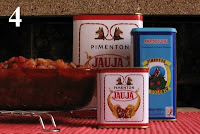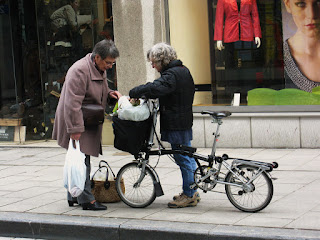Friday, 30 September 2011
Thursday, 29 September 2011
A bit more on Ponte Maceira
Visiting the small hamlet of Ponte Maceira is a real treat.
Cornwall. The main landmark is a beautiful 13th century
bridge, constructed on the foundations of a preceding
Roman one.
The little watermill, just beside the bridge is one of the loveliest
spots I've ever seen in Galicia.
This tiny village is situated in Ames ( parish of Agrôn ), in
the province of La Coruña.
It lays on the route to Santiago de Compostela, and
is a picturesque place, with gentle, green surroundings, where
pilgrims can enjoy a moment of rest.
turismogalicia.blogspot.com

The little watermill, just beside the bridge is one of the loveliest
spots I've ever seen in Galicia.
This tiny village is situated in Ames ( parish of Agrôn ), in
the province of La Coruña.
It lays on the route to Santiago de Compostela, and
is a picturesque place, with gentle, green surroundings, where
pilgrims can enjoy a moment of rest.
turismogalicia.blogspot.com

Wednesday, 28 September 2011
Ponte Maceira
One of the most beautiful spots in Galicia is Ponte Maceira.
 |
| The old manor house by the river Tambre. |
Monday, 26 September 2011
Mosteiro do Couto
 |
| San Martiño de Xuvia |
Saturday, 24 September 2011
Tuesday, 20 September 2011
flea market
There are several markets in Bruges, the principal
 |
| Sunday market, Bruges |
Saturday market is the most busy one. Less
important is the one on Wednesday. And there is a
smaller one on Sunday, nearby the cattle market.
It's always a social event, especially the Sunday market.
They have several stalls where one can have a drink, tapas
and a good chat with friends and neighbours.
Do try the local specialities.
There is a more or less permanent flea market in the
center of Bruges, it attracts only tourists. Locals go to
the occasional swap meets. Or the annual antiques fair
at the end of August.
It's in open air and you can find a wide range of objects;
a 15th century dagger, lying beside some old comics,
cheap Chinese copies of art deco statues, old fridges and
vintage bicycles. Name it, and they have it.
We were hesitating between an old bakelite telephone
and a plastic, full size lobster.
Monday, 19 September 2011
Raversijde
A few months ago, when don G. enjoyed a well -deserved holiday in Spain,
 we went to Ostend, to visit the former Royal Estate of Raversijde.
we went to Ostend, to visit the former Royal Estate of Raversijde.
The wooden chalet in Norwegian style disappeared long ago. But the place
is still magnificent, there was a coastal battery during World War I and it
was also a part of the Atlantic wall, a generation later, when war
devastated our country again.
Those fortifications, kilometers of trenches and corridors, are still intact
and fully equipped, being a real time capsule.
A small fishing village was located on the site in medieval times and
some houses, and a part of the old landscape, are reconstructed.
There is a fine museum too, and a cafeteria where they serve a good lunch.
You can also visit prince Charles little house. The late prince Charles was
regent of Belgium, just after the war and his eccentric character is reflected
in the interior of his home. While we were looking at his collection
of model trains, we had the impression that some sadness ocurred
in the place.
Indeed, if you see a picture of the prince, as a child, or as an old man,
he's never smiling.
www.west-vlaanderen.be/kwaliteit/leefomgeving/raversijde
 we went to Ostend, to visit the former Royal Estate of Raversijde.
we went to Ostend, to visit the former Royal Estate of Raversijde.The wooden chalet in Norwegian style disappeared long ago. But the place
is still magnificent, there was a coastal battery during World War I and it
was also a part of the Atlantic wall, a generation later, when war
devastated our country again.
Those fortifications, kilometers of trenches and corridors, are still intact
and fully equipped, being a real time capsule.
A small fishing village was located on the site in medieval times and
some houses, and a part of the old landscape, are reconstructed.
There is a fine museum too, and a cafeteria where they serve a good lunch.
You can also visit prince Charles little house. The late prince Charles was
regent of Belgium, just after the war and his eccentric character is reflected
in the interior of his home. While we were looking at his collection
of model trains, we had the impression that some sadness ocurred
in the place.
Indeed, if you see a picture of the prince, as a child, or as an old man,
he's never smiling.
www.west-vlaanderen.be/kwaliteit/leefomgeving/raversijde
Thursday, 15 September 2011
Procession of the Holy Blood.
 |
| St.-Leo brass band, Bruges |
Every year we had to participate in the procession of the Holy
Blood.
Quite a nice experience, as long as it was not too warm that day.
The band belongs to the local scout movement. But the red tunic
and classic campaign hat are not ideal for warm summerdays.
Lots of people say we look more like Canadian Mounties than
boy scouts. They have a point there.
This year, doña B., don G. and I went on a beautiful day in May
to Bruges to see the procession.
The event itself is marvellous and is certainly worth the trip.
To my satisfaction I saw my old brass band again. And eighty
poor lads sweating in their uniforms.
Labels:
Bruges,
Flanders,
procession of the Holy Blood,
Брюгге
Tuesday, 13 September 2011
Monday, 12 September 2011
Bruges, brewery " De Halve Maan "
 Yesterday, we went for a walk in Bruges. With far less tourists
Yesterday, we went for a walk in Bruges. With far less touristsand the light of a late summer sun, the town looks already
more charming.
Doña B. decided that we would all have lunch in brewery
" De Halve Maan ". It's an old brewery in the centre of Bruges,
on the Walplein.
They have guided tours, a restaurant and a cosy patio. although I
supposed the place to be one of the many tourist traps, it was a
pleasant experience. It's not very crowdy around this time of the year
and the staff is always friendly and very professional.
The menu consists of traditional local dishes for a moderate price.
Don G. got a beef stew and was very happy with it, and doùna B. and
I choosed the tomatoes, stuffed with shrimps. All came with french
fries and while don G. had a glass of water, we drank a "Brugse Zot",
a heavy blond beer with a very rich flavour.
 Off course, for those seeking the very best of Belgian gastronomy, than
Off course, for those seeking the very best of Belgian gastronomy, thanthere are other ( and more expensive ) restaurants. But if you just want
a good lunch, it's the right place to be.
Try to find a moment when it's not too crowdy. And pay a visit to the
brewery itself, you won't be disappointed.
Anyway, we enjoyed our meal and found it a very satisfying experience.
More information: www.halvemaan.be
www.flandes.net
Labels:
Belgian beer,
Bruges,
Brujas,
De Halve Maan,
Flanders,
Брюгге
Sunday, 11 September 2011
Saturday, 10 September 2011
Authentic Ghent.
Bruges, allas, lost a good part of its identity in an attempt
to please tourists.
Historical buildings became too clean and too neat. Local shops
are replaced by an infinite number of soulless tourist traps were
industrial quantities of chocolates and waffles are sold to an
ignorant public of foreigners.
What a shame, what a pitty!
The good citizens of Ghent were wiser; their town kept
its sparkling, vivid soul. A bit less clean and neat, but eons ahead
Friday, 9 September 2011
Wednesday, 7 September 2011
Tuesday, 6 September 2011
The empanada.
Doña B. made empanada this last sunday and don G. had it all very well documented,
The ingredients you'll need for the dough are the following:
( See picture 5.)
600 grs flour
2 eggs
1,50 dl water
50 cl olive oil
50 grs butter
a small glass of white wine
 some salt
some salt
And for the stuffing: ( see picture 4 )
 2 kilograms of onions
2 kilograms of onions
1 can of peeled red peppers
2 good spoonfulls of Spanish pimentón
a big can of tuna (500 grs) or a similar amount
of minced meat.

Put all the ingredients for the dough in a bowl and mix with
your hands until you can form a ball
( Picture 6 and 7. )
Divide it in two and use one part to cover a tray, a big square
 one that can go into the oven.
one that can go into the oven.
In the mean time, preheat the oven to 160°C.
Put the stuffing. First the vegetables and then the tuna or the
minced meat.
Cover with a second layer of dough and close very well
the edges. And make a hole in the middle of the surface, so
moisture can escape.
Use the remainders of the dough to decorate the empanada.
If tuna is used, the image of some fish is what tradition
 prescribes as decoration, but be creative.
prescribes as decoration, but be creative.
And then, use a brush to paint with egg. It will make your
empanada more shiny.
( Pictures 9 and 10. )
Place it in the oven for about three quarters of an hour.
To check if it's done, see for the bottom, because the surface
can sometimes deceive us.
When ready, let it cool down for a while and serve.






The ingredients you'll need for the dough are the following:
( See picture 5.)
600 grs flour
2 eggs
1,50 dl water
50 cl olive oil
50 grs butter
a small glass of white wine
 some salt
some saltAnd for the stuffing: ( see picture 4 )
 2 kilograms of onions
2 kilograms of onions1 can of peeled red peppers
2 good spoonfulls of Spanish pimentón
a big can of tuna (500 grs) or a similar amount
of minced meat.
Start to cut the onions into little pieces ( mirepoix ), until you
get bored doing so. Then pouch them in the oil intended
for the dough.

( See pictures 1 and 2.)
Add the peeled peppers and the pimentón.
Picture 3 illustrates this very well.
Make sure the mixture is never boiling, certainly not when
the pimentón is added.
Strain it all, so the oil can be used for the dough.
your hands until you can form a ball
( Picture 6 and 7. )
Divide it in two and use one part to cover a tray, a big square
 one that can go into the oven.
one that can go into the oven.In the mean time, preheat the oven to 160°C.
Put the stuffing. First the vegetables and then the tuna or the
minced meat.
Cover with a second layer of dough and close very well
the edges. And make a hole in the middle of the surface, so
moisture can escape.
Use the remainders of the dough to decorate the empanada.
If tuna is used, the image of some fish is what tradition
 prescribes as decoration, but be creative.
prescribes as decoration, but be creative.And then, use a brush to paint with egg. It will make your
empanada more shiny.
( Pictures 9 and 10. )
Place it in the oven for about three quarters of an hour.
To check if it's done, see for the bottom, because the surface
can sometimes deceive us.
When ready, let it cool down for a while and serve.






Subscribe to:
Comments (Atom)





























